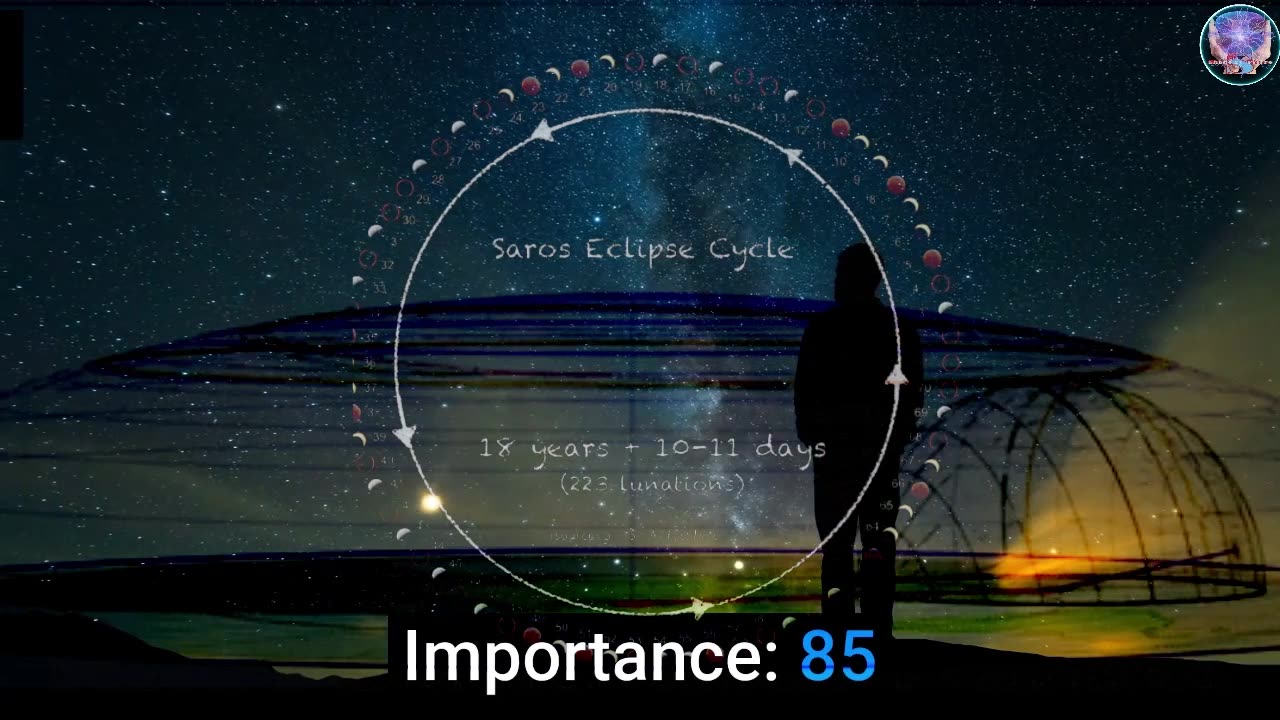Premium Only Content

Lunar Periodicities
Lunar Periodicities
https://publish.obsidian.md/shanesql/Eclipses
Three periodicities related to lunar orbit, the synodic month, the draconic month, and the anomalistic month and they coincide almost perfectly each saros cycle. For an eclipse to occur, either the Moon must be on a part of its path in the sky that lines up in front of the Sun (for a solar eclipse) relative to the observer on earth, or must be on a part of its path in the sky that lines up in behind the Sun (for a lunar eclipse). This can happen only when the Moon is new or full, respectively, and repeat occurrences of these lunar phases result from solar and lunar orbits producing the Moon's synodic period of 29.53059 days. During most full and new moons, however, the optical effect we call the shadow of the Earth or Moon falls to the north or south of the other body. Eclipses occur when the sun and moons orbital path crosses at an ascension or descension node. The period of time for two successive lunar passes through the ecliptic plane (returning to the same node) is termed the draconic month, a 27.21222 day period. The geometry of an eclipse, when the new or full moon is near one of the nodes, occurs every five or six months when the Sun is in conjunction or opposition to the Moon and coincidentally also near a node of the Moon's orbit at that time. Two eclipses separated by one saros have very similar appearance and duration due to the orbital paths lining up perfectly and also occurring at a node: this is because the saros is also an integer multiple of the anomalistic month of 27.5545 days, the period of the moon with respect to the lines of apsides in its orbit.
After one saros, the Moon will have completed roughly a whole number amount of synodic, draconic, and anomalistic periods (223, 242, and 239) and the Sun-Moon geometry will be nearly identical: the Moon will have the same phase and be at the same node and the same distance from the Earth. In addition, because the saros is close to 18 years in length (about 11 days longer), the Earth will be nearly the same distance from the Sun, and tilted to it in nearly the same orientation (same season).
However, there are three other orbital periods or months that are crucial to the understanding and prediction of eclipses. These three cycles and the harmonics between them determine when, where, and how solar and lunar eclipses occur. The Saros arises from a natural harmony between three of the Moon's orbital periods: Synodic Month, Anomalistic Month, and Draconic Month.
(period lengths for 2000 CE)
Synodic Month (New Moon to New Moon) = synodic
29.530589 days - 29d 12h 44m 03s
Anomalistic Month (perigee to perigee) = The point at which moon is furthest away from earth
27.554550 days - 27d 13h 18m 33s
Draconic Month (node to node) =
27.212221 days - 27d 05h 05m 36s
223 Synodic Months =
6585.3223 days
6585d 07h 43
239 Anomalistic Months =
6585.5375 days
6585d 12h 54m
Draconic Months =
6585.3575 days
6585d 08h 35m
-
 54:25
54:25
Anti-Disinfo League
2 months agoA Brief History On Voigt Transformations
488 -
 1:06:17
1:06:17
Graham Allen
2 hours agoFAKE NEWS Is Everywhere!! Are We Living In The Upside Down?!
92.8K367 -
 LIVE
LIVE
Wendy Bell Radio
5 hours agoFeeding Their Greed
7,145 watching -
 LIVE
LIVE
Badlands Media
7 hours agoBadlands Daily: November 26, 2025
3,181 watching -
 1:13:11
1:13:11
Chad Prather
16 hours agoGratitude That Grows in Hard Ground: A Thanksgiving Message for the Soul
55.8K36 -
 LIVE
LIVE
LFA TV
12 hours agoLIVE & BREAKING NEWS! | WEDNESDAY 11/26/25
3,312 watching -
 1:59:03
1:59:03
The Chris Salcedo Show
13 hours ago $7.55 earnedRemembering Rush On A Truly American Holiday
21.8K1 -
 36:24
36:24
Julie Green Ministries
4 hours agoLIVE WITH JULIE
80.2K178 -
 1:05:27
1:05:27
Crypto Power Hour
12 hours ago $7.60 earnedWhat You Need To Know About Gold Tokenization
58.2K7 -
 1:46:14
1:46:14
LIVE WITH CHRIS'WORLD
12 hours agoTHE WAKE UP CALL - 11/26/2025 - Episode 14
25.7K2